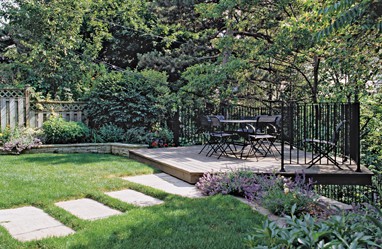My seven spatial archetypes provide a contemplative framework for looking at the world and getting to know your place within it.
A harbor offers sanctuary and quiet refuge.
Photo: Allan Mandell, from Home Outside p.47; Design: Julie Moir Messervy.
It’s 2010: a new year and a new decade and an opportunity to start fresh once more. Some of you have read Contemplative Gardens and The Inward Garden, in which I talk about my theory of “spatial archetypes”—the seven vantage points on the world. As I’ve developed them over the years, these landscape images are also physical, psychological, and spiritual homes for each one of us. I find that if I spend some time each day living in the mindset of each of these “habitats of home,” my life feels rich and well-rounded. Try it and let us know if it works for you as well!

Finding your sea in a koi pond.
Photo: Randy O’Rourke, from Home Outside p.46; Design: Maggie Judycki, GreenThemes, Inc.
1. Sea—Immerse yourself.
Arouse your senses. Surround yourself with music, flowers, atmosphere. Bask in the sunshine or sit in the quiet of a cathedral. Submerge yourself in water. Allow your conscious self to slumber.
2. Cave—Find your focus.
Find shelter in a form-fitting place with a window onto the world. Occupy a contemplative retreat with a framed view of the beyond. Make yourself a burrow, a hollow, a hut, a berth: home.
3. Harbor—Embrace someone. And be embraced.
Enjoy sanctuary in a pair of enclosing arms. Nestle into a port just off the open sea, a booth in a bar, a wingchair in a parlor. Erect boundaries–walls, fences, hedges: make a cloister, court or quad. Define your realm of refuge.

A promontory takes your experience to the edge.
Photo & Design: Victoria Lister Carley, from Home Outside p.47.
4. Promontory—Explore the edge.
Find a new frontier. Stand at the brink. Get to a balcony, overlook, or belvedere. Feel the rapture—and danger—of going beyond your comfort zone.
5. Island—Become the center.
Cut the cord. Float alone on the sea, backed up by all the earth, looking up to the stars above. Know yourself by finding time alone.
6. Mountain—Gain perspective.
Find wisdom at the very top. Occupy a high place: a cupola, tower, or treehouse. Protected yet free. Enjoy the journey upward while watching the miniature world below.
The sky welcomes you to expand your horizons.
Photo & Design: Myke Hodgins & Associates Landscape Architects, from Home Outside p.47.
7. Sky—Transcend the everyday.
Leave the landscape far below: Go for beyondness—Exercise your creativity, fall in love, get a runner’s high, become enlightened. Let your spirits soar. Find your bliss.








Dear Julie,
I’ve been enjoying your blogs so much! I moved back to the US in August because my Filipino partner was coming to UNLV in Las Vegas. Alas his visa was denied due to health reasons. So here I am preparing to move back to the the Philippines for good. I sold my Greenfield house in October. Now trying to sell off stuff. I do have LOTS of beautiful hard-cover garden/design books if you know someone is looking. They don’t sell well in this climate! It is interesting what they have to do to get things to grow here. And the soil? HAHAHA!
I need to get your newest book yet before I go! I designed a garden for the family in the Philippines, and also one here in LV for a Filipino family, which was fun.
I wish you and Steve well always and will continue to look forward to getting your blogs and hearing about what you’re doing! I remember our seminar with great fondness and value so much what you have taught me!
Love always,
Rod Gisick
Hi Julie ~
Since I read The Inward Garden several years ago, I have never thought about space in quite the same way. I love the organized, thoughtful, poetic structure you created for the landscape archetypes. Thank you for your contribution to understanding one of the many ways our minds and bodies are related to and affected by our environment!
Seeking a promontory today,
warmly,
Lisa Bailey
Julie,
I agree, and recommend all to read The Inward Garden. Thank you for developing, then sharing such a clear, concise and applicable view of space.
Bill Healy
Thanks to each of you friends and colleagues for taking the time to comment. It’s always a treat to read what people are thinking about what we write and also to hear how you are doing.
It’s been over twenty years since I first came up with the seven spatial archetypes and they continue to fascinate me and absorb my attention. It often feels uncanny that they explain so much, not only about our feelings for and in the natural landscapes and built spaces around us, but also as a theory of human development and model for how might best live our lives. One of these days, I’ll hope to write all these ideas down and get them out to you all for your thoughts and comments.